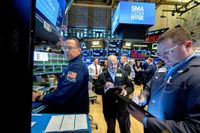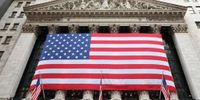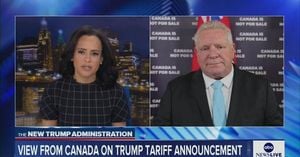U.S. stocks plunged in after-hours trading on April 2, 2025, following President Donald Trump’s announcement of sweeping tariffs that have raised concerns about a potential trade war and its impact on the global economy. Investors reacted swiftly, with Dow futures plummeting more than 1,100 points, or 2.7%, while S&P 500 futures sank 3.9% and Nasdaq 100 futures plunged 4.7%. This dramatic selloff came after a day of gains, where major indices had closed higher in anticipation of the tariff announcement.
Trump's tariffs, which include a baseline 10% on all imports, are set to take effect on April 5, 2025, with higher rates imposed on specific countries, including a staggering 34% on imports from China, 20% on the European Union, and 24% on Japan. The announcement was met with immediate backlash from investors, who had hoped for a less aggressive approach. "Trump is enacting a very aggressive tariff policy, far more aggressive than most investors thought possible six months ago," said Jed Ellerbroek, portfolio manager at Argent Capital. "Painful times for stock market investors."
Following the announcement, key Asian markets also reacted negatively. Japan’s Nikkei 225 index tumbled at least 4%, while South Korea’s KOSPI and Hong Kong’s Hang Seng Index fell by 2.7% and 2.4%, respectively. Taiwan’s TAIEX fluctuated but ultimately showed a slight increase of less than 1%.
The selloff turned into a rout as investors began to fully comprehend the extent of the tariffs. Major technology stocks were particularly hard hit, with Apple (AAPL) dropping more than 7%, Tesla (TSLA) falling over 6%, and Amazon (AMZN) declining by more than 5%. Other notable losers included Nike (NKE) and Walmart (WMT), which both retreated by 7%. Dan Ives, senior analyst at Wedbush Securities, characterized the tariff announcement as "worse than the worst-case scenario" that Wall Street had been fearing.
While the Trump administration maintains that these tariffs are necessary to protect American industry and jobs, economists warn that they could stoke inflation and hinder economic growth. JoAnne Bianco, chief investment strategist at BondBloxx, noted that the U.S. is likely to face elevated uncertainty and market volatility as the implications of Trump’s tariffs unfold. "The roller coaster ride continues as the initial leaks were positive, but then the details were released and they were far worse than expected," said Chris Zaccarelli, chief investment officer at Northlight Asset Management.
In the lead-up to the announcement, market sentiment had been cautiously optimistic. On April 1, the Dow Jones Industrial Average had climbed 350 points, buoyed by hopes that the tariffs would be less severe than anticipated. However, as details emerged, it became clear that the tariffs would impact a wide range of goods, leading to a swift reversal in market fortunes.
Trump's tariffs are not only set to affect imports from China, Japan, and the EU but also extend to countries like India, which will face a 26% reciprocal tariff. The automobile sector is particularly vulnerable, with a flat 25% tariff on all vehicle imports, which could have significant implications for manufacturers reliant on global supply chains.
Amidst the turmoil, U.S. Treasury Secretary Scott Bessent downplayed the market's reaction, stating that the selloff was "a Mag 7 problem not a MAGA problem," referring to the "Magnificent Seven" tech stocks. However, the broader implications of the tariffs are concerning, with analysts predicting that they could lead to a recession if retaliatory measures are implemented by affected countries.
As the market digests the ramifications of these tariffs, many investors are left wondering about the future economic landscape. Some experts suggest that this could be a starting point for negotiations with other countries, potentially leading to lower tariff rates in the long run. However, for now, uncertainty reigns, and traders are reacting with caution.
In the aftermath of the announcement, the SPDR S&P 500 ETF (SPY) dropped 3.5%, while the Invesco QQQ ETF (QQQ), which tracks the Nasdaq 100, fell 4.4%. Futures tied to the Dow Jones Industrial Average indicated a decline of more than 1,000 points, signaling a turbulent trading session ahead.
The economic implications of Trump’s tariffs extend beyond immediate stock market reactions. Economists predict that the tariffs could limit disposable income for consumers and businesses alike, leading to decreased spending and investment. Comerica Bank’s Chief Economist Bill Adams stated that the tariffs would weigh on economic growth and hiring throughout 2025, adjusting their GDP forecast down to 1.7% from 2.5%.
As the dust settles, market participants will be closely monitoring how U.S. trading partners respond to these tariffs. The potential for retaliatory tariffs could escalate tensions further, complicating an already fragile economic environment. Investors and analysts alike are left grappling with the uncertainty of how these trade policies will unfold in the coming months.
In conclusion, President Trump’s sweeping tariff announcement has sent shockwaves through the financial markets, prompting fears of a trade war that could have far-reaching consequences for the global economy. As investors brace for potential retaliatory measures and assess the impact on various sectors, the economic outlook remains precarious.









